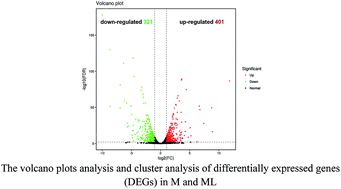Comparative transcriptomic analysis reveals the regulatory effects of inorganic nitrogen on the biosynthesis of Monascus pigments and citrinin†
Abstract
Monascus spp. and its secondary metabolites have been widely applied in foods and medicines for thousands of years in eastern Asia. Nitrogen sources are essential nutrients for the growth and metabolism of Monascus spp. Our previous study found that inorganic nitrogen sources (especially NH4Cl and NH4NO3) promoted the biosynthesis of Monascus pigments (MPs) and inhibited the production of citrinin. The objective of the present study was to investigate the regulatory mechanism of inorganic nitrogen on the biosynthesis of MPs and citrinin by the comparative transcriptional approach (RNA sequencing combined with RT-qPCR). Results indicated that the submerged fermentation of M. purpureus M3103 with NH4Cl or NH4NO3 as the sole nitrogen source can significantly increase the yields of MPs (especially for Monascus orange and red pigments) and decrease citrinin production, compared with the organic nitrogen source (peptone group). Comparative transcriptomic profiling by RNA sequencing found that the numbers of differentially expressed genes (DEGs) between different experimental groups—M group (peptone group) vs. ML group (NH4Cl group), and M group (peptone group) vs. MX group (NH4NO3 group), were 722 and 1287, respectively. Kyoto Encyclopedia of Genes and Genomes (KEGG) pathway analysis revealed that genes involved in carbon and nitrogen metabolism, biosynthesis of amino acids were up-regulated by NH4Cl and NH4NO3, which would produce more biosynthetic precursors for MPs. Whereas, the inorganic nitrogen source (both of NH4Cl and NH4NO3) down-regulated the expression levels of genes involved in tyrosine metabolism. In addition, NR analysis indicated that the essential genes and transcription factors involved in the biosynthesis pathway of citrinin were down-regulated by NH4Cl and NH4NO3. These results indicated that NH4Cl or NH4NO3 as a nitrogen source for M. purpureus M3103 can significantly promote the precursor synthesis of Monascus pigments, but reduce the transcription of polyketide synthase for citrinin, and therefore significantly increase Monascus pigments production and decrease citrinin formation. These findings will facilitate a comprehensive understanding of the regulatory mechanisms of inorganic nitrogen in the biosynthesis of secondary metabolites in M. purpureus, and would benefit the application of M. purpureus in the production of MPs.



 Please wait while we load your content...
Please wait while we load your content...